Blog
Blog
Podiatrists Can Help With Plantar Fasciitis
 Plantar fasciitis is a painful condition characterized by inflammation of the plantar fascia, which is the thick band of tissue that runs along the bottom of the foot and connects the heel bone to the toes. This condition typically causes sharp, stabbing pain in the heel, especially during the first steps in the morning or after periods of inactivity. Plantar fasciitis occurs due to excessive strain on the plantar fascia, which can result from overuse, high-impact activities, improper footwear, or anatomical issues like flat feet or high arches. Prolonged standing or weight gain can also contribute to its development. Treatment options for plantar fasciitis include rest, stretching exercises, and mild pain relievers. Custom orthotics can provide additional arch support and alleviate pressure on the plantar fascia. If you have persistent heel pain, it is suggested that you schedule an appointment with a podiatrist who can offer an expert diagnosis, personalized treatment plans, and guidance on preventive measures.
Plantar fasciitis is a painful condition characterized by inflammation of the plantar fascia, which is the thick band of tissue that runs along the bottom of the foot and connects the heel bone to the toes. This condition typically causes sharp, stabbing pain in the heel, especially during the first steps in the morning or after periods of inactivity. Plantar fasciitis occurs due to excessive strain on the plantar fascia, which can result from overuse, high-impact activities, improper footwear, or anatomical issues like flat feet or high arches. Prolonged standing or weight gain can also contribute to its development. Treatment options for plantar fasciitis include rest, stretching exercises, and mild pain relievers. Custom orthotics can provide additional arch support and alleviate pressure on the plantar fascia. If you have persistent heel pain, it is suggested that you schedule an appointment with a podiatrist who can offer an expert diagnosis, personalized treatment plans, and guidance on preventive measures.
Many people suffer from bouts of heel pain. For more information, contact Steven Spivak, DPM of Mount Holly Family Footcare. Our doctor can provide the care you need to keep you pain-free and on your feet.
Causes of Heel Pain
Heel pain is often associated with plantar fasciitis. The plantar fascia is a band of tissues that extends along the bottom of the foot. A rip or tear in this ligament can cause inflammation of the tissue.
Achilles tendonitis is another cause of heel pain. Inflammation of the Achilles tendon will cause pain from fractures and muscle tearing. Lack of flexibility is also another symptom.
Heel spurs are another cause of pain. When the tissues of the plantar fascia undergo a great deal of stress, it can lead to ligament separation from the heel bone, causing heel spurs.
Why Might Heel Pain Occur?
- Wearing ill-fitting shoes
- Wearing non-supportive shoes
- Weight change
- Excessive running
Treatments
Heel pain should be treated as soon as possible for immediate results. Keeping your feet in a stress-free environment will help. If you suffer from Achilles tendonitis or plantar fasciitis, applying ice will reduce the swelling. Stretching before an exercise like running will help the muscles. Using all these tips will help make heel pain a condition of the past.
If you have any questions please contact our office located in Lumberton, NJ . We offer the newest diagnostic and treatment technologies for all your foot and ankle needs.
Arthritis Can Cause Pain in the Feet and Ankles
Symptoms and Relief From Sever’s Disease
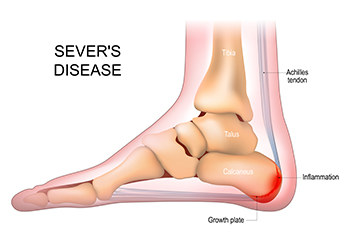
Sever's disease, also known as calcaneal apophysitis, is a common condition affecting children and adolescents during growth spurts. It involves inflammation of the growth plate in the heel bone, typically occurring in active children aged eight to 14. Symptoms can include heel pain that worsens with activity, limping, and tenderness when pressing on the back of the heel. Factors contributing to Sever's disease include repetitive stress from sports activities like running and jumping, as well as tight Achilles tendons or flat feet. Finding relief involves reducing activity levels that exacerbate symptoms, using heel cushions or orthotic inserts to support the heel, and performing stretching exercises to improve flexibility in the calf muscles and Achilles tendon. Wearing proper footwear with adequate cushioning and support can also alleviate discomfort. If your child has heel pain and enjoys participating in sporting activities, it is suggested that you consult a podiatrist who can provide an accurate diagnosis and treatment.
Sever's disease often occurs in children and teens. If your child is experiencing foot or ankle pain, see Steven Spivak, DPM from Mount Holly Family Footcare. Our doctor can treat your child’s foot and ankle needs.
Sever’s Disease
Sever’s disease is also known as calcaneal apophysitis, which is a medical condition that causes heel pain I none or both feet. The disease is known to affect children between the ages of 8 and 14.
Sever’s disease occurs when part of the child’s heel known as the growth plate (calcaneal epiphysis) is attached to the Achilles tendon. This area can suffer injury when the muscles and tendons of the growing foot do not keep pace with bone growth. Therefore, the constant pain which one experiences at the back of the heel will make the child unable to put any weight on the heel. The child is then forced to walk on their toes.
Symptoms
Acute pain – Pain associated with Sever’s disease is usually felt in the heel when the child engages in physical activity such as walking, jumping and or running.
Highly active – Children who are very active are among the most susceptible in experiencing Sever’s disease, because of the stress and tension placed on their feet.
If you have any questions, please feel free to contact our office located in Lumberton, NJ . We offer the newest diagnostic and treatment technologies for all your foot and ankle injuries.
What Are the Signs of Toenail Fungus?
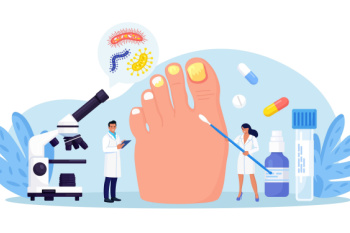
Toenail fungus, also known as onychomycosis, is a common condition caused by various fungi that thrive in warm, moist environments. Frequent exposure to such environments, like public swimming pools or showers, can increase the risk of infection. Additionally, wearing tight or non-breathable shoes and having minor skin or nail injuries can also make toenails more susceptible to fungal infections. Symptoms of toenail fungus can include thickened, discolored, or brittle nails that may become distorted in shape. The affected nails may also separate from the nail bed, and a foul odor can develop. In some cases, the surrounding skin may appear red and inflamed. Early detection and treatment are critical to prevent the infection from spreading and causing further complications. Maintaining good foot hygiene and wearing breathable footwear can help reduce the risk of toenail fungus. If you have developed this condition, it is suggested that you contact a podiatrist who can successfully treat it, which most likely will include prescribed medication.
For more information about treatment, contact Steven Spivak, DPM of Mount Holly Family Footcare. Our doctor can provide the care you need to keep you pain-free and on your feet.
Toenail Fungus Treatment
Toenail fungus is a condition that affects many people and can be especially hard to get rid of. Fortunately, there are several methods to go about treating and avoiding it.
Antifungals & Deterrence
Oral antifungal medicine has been shown to be effective in many cases. It is important to consult with a podiatrist to determine the proper regiment for you, or potentially explore other options.
Applying foot powder on the feet and shoes helps keep the feet free of moisture and sweat.
Sandals or open toed shoes – Wearing these will allow air movement and help keep feet dry. They also expose your feet to light, which fungus cannot tolerate. Socks with moisture wicking material also help as well.
If you have any questions please feel free to contact our office located in Lumberton, NJ . We offer the newest diagnostic tools and technology to treat your foot and ankle needs.
Best Exercises for Flat Feet
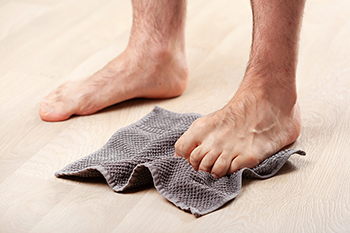
Flat feet can cause discomfort and impact overall mobility, and specific exercises can help strengthen the arches and alleviate symptoms. Towel scrunches are effective, and can be done by simply placing a towel on the floor, using your toes to scrunch it toward you, then release. Toe extensions involve sitting with your feet flat and lifting only your toes while keeping the rest of your foot on the ground. The stork stretch, where you balance on one foot while pulling the other foot towards your buttocks, helps improve balance and strengthen the foot muscles. Using a foot roller, back and forth under your arch, massages and stretch the muscles. These exercises, when practiced regularly, can enhance arch strength, reduce pain, and improve the overall function of flat feet. Flat feet can cause discomfort while standing or walking. If you have flat feet, it is suggested that you confer with a podiatrist who can perform a comprehensive foot exam and offer relief solutions, if needed.
Flatfoot is a condition many people suffer from. If you have flat feet, contact Steven Spivak, DPM from Mount Holly Family Footcare. Our doctor will treat your foot and ankle needs.
What Are Flat Feet?
Flatfoot is a condition in which the arch of the foot is depressed and the sole of the foot is almost completely in contact with the ground. About 20-30% of the population generally has flat feet because their arches never formed during growth.
Conditions & Problems:
Having flat feet makes it difficult to run or walk because of the stress placed on the ankles.
Alignment – The general alignment of your legs can be disrupted, because the ankles move inward which can cause major discomfort.
Knees – If you have complications with your knees, flat feet can be a contributor to arthritis in that area.
Symptoms
- Pain around the heel or arch area
- Trouble standing on the tip toe
- Swelling around the inside of the ankle
- Flat look to one or both feet
- Having your shoes feel uneven when worn
Treatment
If you are experiencing pain and stress on the foot you may weaken the posterior tibial tendon, which runs around the inside of the ankle.
If you have any questions please feel free to contact our office located in Lumberton, NJ . We offer the newest diagnostic and treatment technologies for all your foot and ankle needs.
Facts About Hammertoe
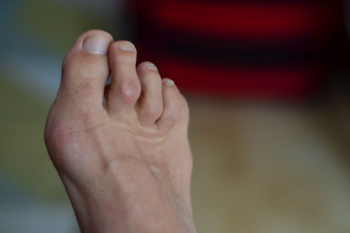 Hammertoe is a deformity causing one or more of the smaller toes to bend abnormally at the middle joint, resembling a hammer. This condition arises primarily due to muscle imbalances that lead to increased pressure on the tendons and joints of the toe. Common causes include wearing ill-fitting shoes, particularly those that are too tight or have high heels, as well as genetic predispositions and conditions like arthritis. Symptoms of hammertoe include pain or irritation while wearing shoes, corns and calluses on the toe, redness and swelling, and in severe cases, open sores. The affected toe may become rigid over time, making movement difficult and painful. Preventing hammertoe involves wearing properly fitting shoes with adequate toe room, avoiding high heels, and performing toe-stretching exercises to maintain flexibility. Early intervention is key to managing the condition effectively. Treatment options range from non-surgical methods, such as wearing custom orthotic devices, using padding to reduce pressure, and taking anti-inflammatory medications, to surgical procedures for severe cases where the toe has become rigid. Surgery typically involves realigning the toe and correcting the deformity. Complications of untreated hammertoe can include chronic pain, difficulty in walking, and persistent sores or infections, which can lead to further foot problems. If you have an uncomfortable hammertoe, it is suggested that you visit a podiatrist for an accurate diagnosis and a tailored treatment plan.
Hammertoe is a deformity causing one or more of the smaller toes to bend abnormally at the middle joint, resembling a hammer. This condition arises primarily due to muscle imbalances that lead to increased pressure on the tendons and joints of the toe. Common causes include wearing ill-fitting shoes, particularly those that are too tight or have high heels, as well as genetic predispositions and conditions like arthritis. Symptoms of hammertoe include pain or irritation while wearing shoes, corns and calluses on the toe, redness and swelling, and in severe cases, open sores. The affected toe may become rigid over time, making movement difficult and painful. Preventing hammertoe involves wearing properly fitting shoes with adequate toe room, avoiding high heels, and performing toe-stretching exercises to maintain flexibility. Early intervention is key to managing the condition effectively. Treatment options range from non-surgical methods, such as wearing custom orthotic devices, using padding to reduce pressure, and taking anti-inflammatory medications, to surgical procedures for severe cases where the toe has become rigid. Surgery typically involves realigning the toe and correcting the deformity. Complications of untreated hammertoe can include chronic pain, difficulty in walking, and persistent sores or infections, which can lead to further foot problems. If you have an uncomfortable hammertoe, it is suggested that you visit a podiatrist for an accurate diagnosis and a tailored treatment plan.
Hammertoes can be a painful condition to live with. For more information, contact Steven Spivak, DPM of Mount Holly Family Footcare. Our doctor will answer any of your foot- and ankle-related questions.
Hammertoe
Hammertoe is a foot deformity that occurs due to an imbalance in the muscles, tendons, or ligaments that normally hold the toe straight. It can be caused by the type of shoes you wear, your foot structure, trauma, and certain disease processes.
Symptoms
- Painful and/or difficult toe movement
- Swelling
- Joint stiffness
- Calluses/Corns
- Physical deformity
Risk Factors
- Age – The risk of hammertoe increases with age
- Sex – Women are more likely to have hammertoe compared to men
- Toe Length – You are more likely to develop hammertoe if your second toe is longer than your big toe
- Certain Diseases – Arthritis and diabetes may make you more likely to develop hammertoe
Treatment
If you have hammertoe, you should change into a more comfortable shoe that provides enough room for your toes. Exercises such as picking up marbles may strengthen and stretch your toe muscles. Nevertheless, it is important to seek assistance from a podiatrist in order to determine the severity of your hammertoe and see which treatment option will work best for you.
If you have any questions, please feel free to contact our office located in Lumberton, NJ . We offer the newest diagnostic and treatment technologies for all your foot care needs.
Gout Pain Can Be Managed
Symptoms and Causes of Bunions
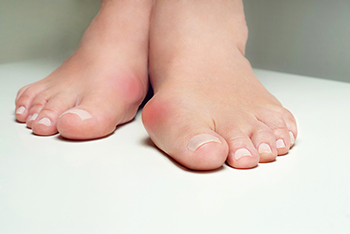
Bunions are bony bumps that form at the base of the big toe, causing it to deviate toward the other toes. This misalignment can lead to pain, swelling, and redness surrounding the joint. Symptoms often include a pronounced bump on the side of the foot, discomfort while walking, and restricted movement of the big toe. Bunions are typically caused by inherited foot structure abnormalities, but they can also result from or made worse by wearing tight or ill-fitting shoes that compress the toes. High heels and narrow-toed shoes are common culprits. Other contributing factors include arthritis and prolonged pressure on the feet. Early intervention with proper footwear, orthotic devices, and, in severe cases, surgery can alleviate symptoms and prevent further progression. A bunion can be painful and unsightly. If you have developed this foot condition, it is suggested that you visit a podiatrist who can offer you appropriate relief treatment methods.
If you are suffering from bunions, contact Steven Spivak, DPM of Mount Holly Family Footcare. Our doctor can provide the care you need to keep you pain-free and on your feet.
What Is a Bunion?
A bunion is formed of swollen tissue or an enlargement of boney growth, usually located at the base joint of the toe that connects to the foot. The swelling occurs due to the bones in the big toe shifting inward, which impacts the other toes of the foot. This causes the area around the base of the big toe to become inflamed and painful.
Why Do Bunions Form?
Genetics – Susceptibility to bunions are often hereditary
Stress on the feet – Poorly fitted and uncomfortable footwear that places stress on feet, such as heels, can worsen existing bunions
How Are Bunions Diagnosed?
Doctors often perform two tests – blood tests and x-rays – when trying to diagnose bunions, especially in the early stages of development. Blood tests help determine if the foot pain is being caused by something else, such as arthritis, while x-rays provide a clear picture of your bone structure to your doctor.
How Are Bunions Treated?
- Refrain from wearing heels or similar shoes that cause discomfort
- Select wider shoes that can provide more comfort and reduce pain
- Anti-inflammatory and pain management drugs
- Orthotics or foot inserts
- Surgery
If you have any questions, please feel free to contact our office located in Lumberton, NJ . We offer the newest diagnostic and treatment technologies for all your foot care needs.
Treatment and Prevention of Common Foot Problems
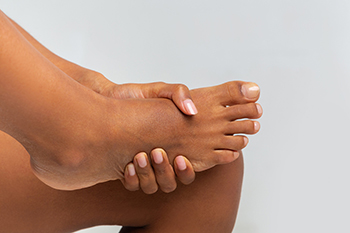
Throughout your life, your feet will carry you thousands of miles, enduring wear and tear that can lead to various common foot problems. Aging feet are prone to widening and arch collapse, which can increase the likelihood of issues like plantar fasciitis, flat feet, and osteoarthritis. Regular self-examinations can help you identify early signs of trouble, such as calluses, blisters, and discolored toenails, which may require changes in footwear or custom orthotics. Plantar fasciitis, marked by heel pain, often benefits from performing specific exercises, and supportive shoe inserts. Flat feet, where your arches have flattened out, can cause discomfort and swelling, best managed with orthotic inserts and shoes with arch support. Additionally, osteoarthritis in your feet can lead to joint pain and stiffness, manageable through topical pain relievers, anti-inflammatory medications, and sometimes corticosteroid injections. Proactive foot care and seeking timely treatment for foot problems are important ways to maintain your mobility and improve quality of life. If you are experiencing persistent foot pain or discomfort, it is suggested that you schedule an appointment with a podiatrist for specialized foot care.
Everyday foot care is very important to prevent infection and other foot ailments. If you need your feet checked, contact Steven Spivak, DPM from Mount Holly Family Footcare. Our doctor can provide the care you need to keep you pain-free and on your feet.
Everyday Foot Care
Often, people take care of their bodies, face and hair more so than they do for their feet. But the feet are a very important aspect of our bodies, and one that we should pay more attention to. Without our feet, we would not be able to perform most daily tasks.
It is best to check your feet regularly to make sure there are no new bruises or cuts that you may not have noticed before. For dry feet, moisturizer can easily be a remedy and can be applied as often as necessary to the affected areas. Wearing shoes that fit well can also help you maintain good foot health, as well as making it easier to walk and do daily activities without the stress or pain of ill-fitting shoes, high heels, or even flip flops. Wearing clean socks with closed shoes is important to ensure that sweat and bacteria do not accumulate within the shoe. Clean socks help to prevent Athlete’s foot, fungi problems, bad odors, and can absorb sweat.
If you have any questions please feel free to contact our office located in Lumberton, NJ . We offer the newest diagnostic and treatment technologies for all your foot and ankle needs.
Effective Foot Stretches and Their Benefits
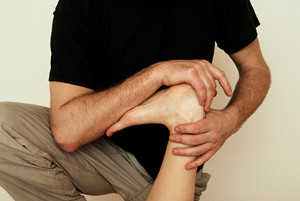
Foot stretches offer a simple yet powerful way to improve flexibility, relieve tension, and prevent injuries. One effective stretch is the toe stretch, where you sit back on your heels, gently pressing your toes into the ground to stretch the top of the foot. Another beneficial stretch is the calf stretch, achieved by placing hands on a wall, stepping one foot back, and pressing the heel into the ground while keeping the back leg straight. Additionally, the plantar fascia stretch targets the sole of the foot, as you sit with one leg crossed over the other, gently pulling your toes back towards the shin. These stretches can alleviate discomfort caused by conditions like plantar fasciitis and Achilles tendonitis, while also enhancing overall foot mobility and function. Incorporating these stretches into your daily routine, especially before and after physical activity. If you are interested in learning more about specific foot stretches and how they can help relieve foot pain, it is suggested that you contact a podiatrist.
Why Stretching Is Important for Your Feet
Stretching the feet is a great way to prevent injuries. If you have any concerns with your feet consult with Steven Spivak, DPM from Mount Holly Family Footcare. Our doctor will assess your condition and provide you with quality foot and ankle treatment.
Stretching the Feet
Stretching the muscles in the foot is an important part in any physical activity. Feet that are tight can lead to less flexibility and make you more prone to injury. One of the most common forms of foot pain, plantar fasciitis, can be stretched out to help ease the pain. Stretching can not only ease pain from plantar fasciitis but also prevent it as well. However, it is important to see a podiatrist first to determine if stretching is right for you. Podiatrists can also recommend other ways to stretch your feet. Once you know whether stretching is right for you, here are some excellent stretches you can do.
- Using a foam roller or any cylindrical object (a water bottle or soda can will do), roll the object under your foot back and forth. You should also exert pressure on the object. Be sure to do this to both feet for a minute. Do this exercise three times each.
- Similar to the previous exercise, take a ball, such as a tennis ball, and roll it under your foot while seated and exert pressure on it.
- Grab a resistance band or towel and take a seat. If you are using a towel, fold it length wise. Next put either one between the ball of your foot and heel and pull with both hands on each side towards you. Hold this for 15 seconds and then switch feet. Do this three times for each foot.
- Finally hold your big toe while crossing one leg over the other. Pull the toe towards you and hold for 15 seconds. Once again do this three times per foot.
It is best to go easy when first stretching your foot and work your way up. If your foot starts hurting, stop exercising to ice and rest the foot. It is advised that you then see a podiatrist for help.
If you have any questions, please feel free to contact our office located in Lumberton, NJ . We offer the newest diagnostic and treatment technologies for all your foot care needs.






